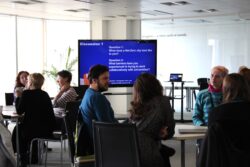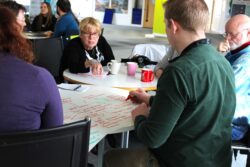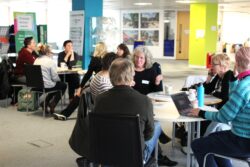Advancing Together Through University-Community Collaboration

In November, the University of Leeds Sustainability Service hosted an engaging discussion on community-university collaboration with twelve representatives from community organisations.
The day’s discussions aimed to better understand how the University of Leeds can accelerate its work around the second principle of the Climate Plan, “Supporting a Net Zero City”.
Held at the Imagine Leeds climate hub in the city centre, it was a morning of conversation around what barriers exist for community organisations collaborating with the University, what mutual benefits exist for partnerships between academics and students working with community organisations, and what a “Net Zero City” might look like.
The organisations involved do incredible work in and around Leeds to create a more resilient city. This includes changing our use of land and creating more local food systems, as well as reconnecting with our local rivers and water ways, creating arts and culture events that are sustainable, and pushing forward climate action.
Led by the Sustainability Service’s officers for the Living Labs and Positive Impact Partnerships initiatives, Jane Dickinson and Dr. Rebecca Brunk, we were also joined by representatives from the University’s Priestley Centre and the Horizon Institute.
By gaining the perspective and expertise of community organisations working toward climate resilience in the city, the University is better positioned to build the capacity of university-city-community collaborations that are essential to addressing the issues and impacts of the climate crises.

The ‘Net Zero City’ from a community perspective
Our conversation with community partners began by asking what they envision a ‘Net Zero City’ to be.
Through this discussion, representatives from community organisations voiced the desire for a broader interpretation of net zero than just a focus on reducing carbon emissions. Energy use was identified as an important focus, especially within the context of public transport.
However, the representatives that joined us were keenly aware of the intersectionality of environmental impact, affordability and the need for people-centred design required in truly sustainable development. These three themes of sustainability were identified throughout the variety of topics that were brought up by representatives when asked to imagine what a ‘net zero’ Leeds could look like. The representatives envisioned transportation systems that are reliable, affordable, accessible and that connect the wider region. Opportunities for active travel and cycle lanes through green spaces that feel safe and increased urban nature and care for our under-utilised blue spaces.
Yet the ideas for a ‘net zero city’ also expanded into the social and political areas of people’s lives too, with discussions on the transition to green jobs and greener education, local democracy, and a significant focus on the need for greater communication and collaboration within the city - with businesses, universities and communities working together to tackle these issues.
Their vision of a net zero city reflects the need for sustainability oriented systemic change across a variety of aspects of city living.

What are the current barriers to community-university collaboration?
We asked the representatives who joined us what barriers currently exist that hinder collaboration between the university and their organisations, and what they identified as top priorities for capacity building.
The idea of greater communication arose once again in our discussion of what barriers currently exist preventing collaboration between the university and community organisations. Representatives voiced their desire for more visibility of the research that is currently happening within the University regarding climate change, and the opportunity to discuss how research can link to tangible climate action.
Two other significant barriers to collaboration that representatives identified were around the capacity to engage in collaboration, which often requires funding, and the difficulty of navigating the complex structure of the University to find the right people to collaborate with.
Engaging with representatives from the third sector to identify these barriers was critical to make sure our Positive Impact Partnerships and Living Lab initiatives are truly co-created. We thank all the representatives who joined us for engaging us in conversation. We will use this knowledge to inform our own practice, as well as share it with colleagues who are also working to build the university’s capacity for collaboration. This includes the University’s Horizon Institute, Community Engaged Network for Teaching, Research and Civic Engagement (CENTRE), and the Leeds Climate Commision.

What are the benefits of community-university collaboration?
Although this session focused on what barriers exist, the benefits of collaboration also came up in our discussion. Collaborating with community organisations provide real world challenges for students and academics to apply their knowledge and expertise to.
These types of partnerships give students the opportunity for experiential learning and build the skills needed to address complex social, economic, and environmental challenges. They give academics and community organisations the opportunity to create research where theoretical and practical knowledge complement each other. Funders want impactful research with wide reaching benefits for society, and community organisations are often embedded within communities whose voices need to be heard.
With the complexity of the social, environmental and political challenges that all need to be a part of our city’s response to climate change, this event demonstrated the importance of a strong practice of collaboration between the third sector and the university. By working together, we can create the ‘net zero city’ of our wildest imaginations.
Want to work together?
If you’re a student, academic, or work for a community organisation that is interested in university-community collaboration, get in touch by emailing sustainability@leeds.ac.uk to discuss a Positive Impact Partnership or learn more about our Living Labs initiative.
United Nations Sustainable Development Goals
We use the United Nations Sustainable Development Goals (SDGs) as a framework to guide our activity. Our work on Positive Impact Partners is linked to the following SDGs:
-
-
- Goal 9: Industry, innovation and infrastructure
- Goal 10: Reduced inequalities
- Goal 11: Sustainable cities and communities
- Goal 17: Partnerships
-
Find out more about our impact on the SDGs.




